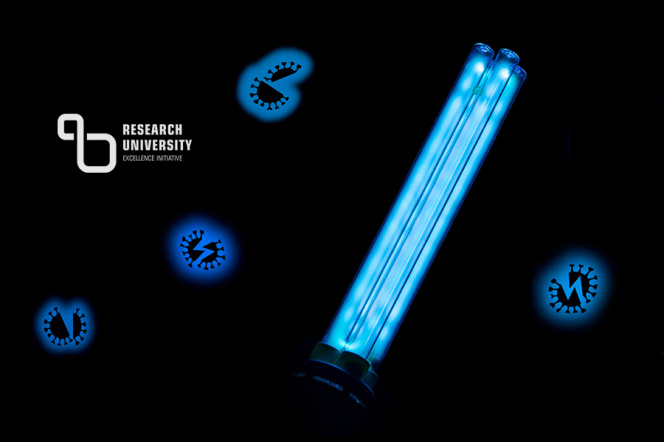Date added: 2022-04-25
Effective room disinfection through a simple virucidal system

UV radiation, and particularly its range with the shortest wavelength, i.e. UV-C, has biocidal properties. When bacteria or viruses are irradiated for a certain time, they die. UV-C radiation practically does not occur in the environment, it does not reach the Earth's surface because of absorption by the atmosphere of Earth. The only sources of UV-C radiation in life and work environment are man-made artificial sources. These can be both various types of electric radiators (UV-C fluorescent lamps, medium-pressure mercury lamps, xenon lamps, and recently LED sources), as well as technological sources, i.e. those that emit UV-C radiation as a side effect.
The biocidal properties of UV-C are widely known and used in many circumstances, including medical facilities, public transport, beauty sector, etc. Unfortunately, long exposure to this type of radiation is dangerous for humans - it can, for example, cause cancer. This poses a problem with implementation of devices emitting this type of radiation in rooms that require precise disinfection.
– Nowadays, such biocidal devices would be useful in every lecture room, laboratory, shop, etc., however it is problematic in many respects – says Wojciech Wojnowski, Ph.D., the manager of the project, explaining its genesis. – That is why we wanted to develop a system that is, above all, safe, but also cheap, accessible to everyone. Specialized devices for UV-C emission are often beyond the budget of institutions such as schools, so we were looking for a safe and cheap way. We decided to use the resources that are already in the rooms - raster fittings.
The originator of the entire project is Tomasz Chludziński, M.Sc.Eng. from the Faculty of Electronics, Telecommunications and Informatics (WETI). The researcher proposed a solution to install UV-C fluorescent lamps in the existing lighting cassettes of a selected room. In each of the luminaires, one of four fluorescent lamps was replaced. The system was integrated with a specially designed application and a motion sensor. Any movement in the room caused the fluorescent lamps to be turned off immediately so as not to expose the people to radiation.
– We wanted to create a simple, low-cost disinfection system ensuring effectiveness, which is additionally easy to install and use - emphasizes Tomasz Chludziński – The project joined scientists from many fields - chemistry, electronics and architecture. Consequently, we were able to look at one aspect from many scientific aspects.
– We tested this system in one of the computer laboratories at WETI – adds Wojciech Wojnowski – in order to check whether during a fifteen-minute break between classes it is possible to deliver enough radiation to various surfaces in a given room for the biocidal effect to work.
Photometric tests were performed, which showed that this method is effective and a quarter of an hour is enough for UV-C to have a biocidal effect on many viruses, bacteria and some fungi.
When replacing a certain number of fluorescent lamps in the room, it is also necessary to verify whether, due to the reduced light intensity, it still meets the lighting standards. Therefore, scientists from the Faculty of Architecture – Justyna Martyniuk-Pęczek Ph.D., Rafał Janowicz, Ph.D. D.Sc. and Natalia Sokół, Ph.D. who specialize in research on the appropriate lighting of rooms, as well as the Independent Photometric Laboratory "ViTom Light & Energy" of Tomasz Przytarski, were invited to join the research.
In the tested room, the standards were not disturbed, however, each room should be monitored individually - e.g. due to its cubic capacity and type of use. Therefore, the researchers plan to add a function to the created application which would monitor the intensity of visible light in the room.
– The project is at the stage of patent application – adds Wojciech Wojnowski – Our idea can be applied wherever there are raster fittings - mainly in public buildings: hospitals, schools, offices. It can be helpful not only during the pandemic, because it works not only against SARS viruses, but many other viruses, bacteria and some types of fungi.
The project is a part of the “Curium Comabting Coronavirus” program, conducted as an element of the “Initiative of Excellence - Research University”.

The project is a part of the “Curium Comabting Coronavirus” program, conducted as an element of the “Initiative of Excellence - Research University”, Task I.3. aiming at increasing the number of prestigious international projects within the scope of PRA and their implementation.
Granted funds – PLN 48 990
Project implemented within BioTechMed Center

